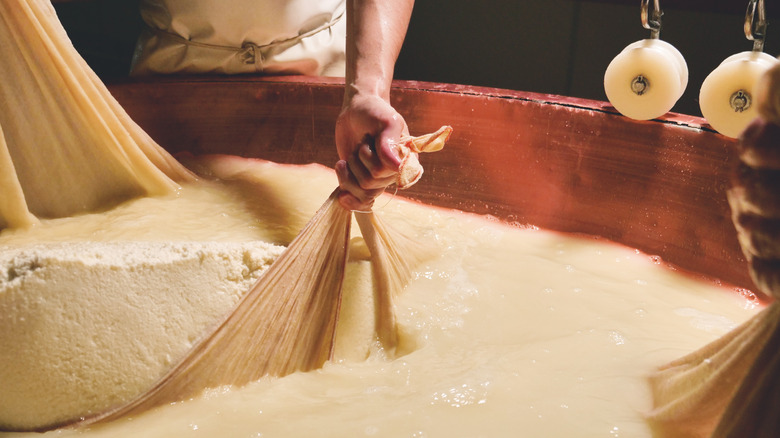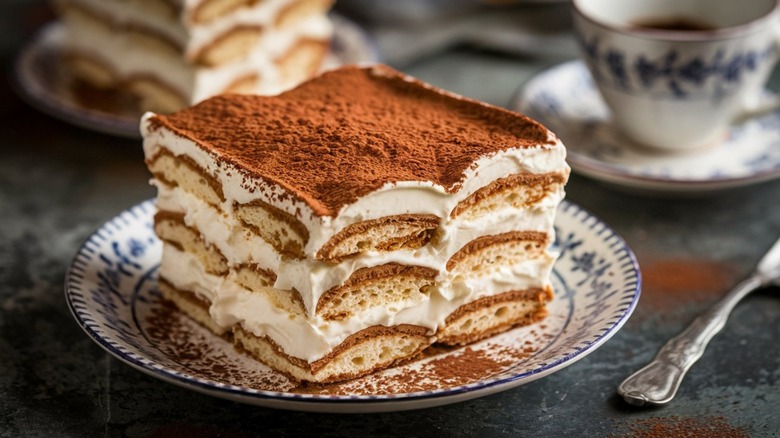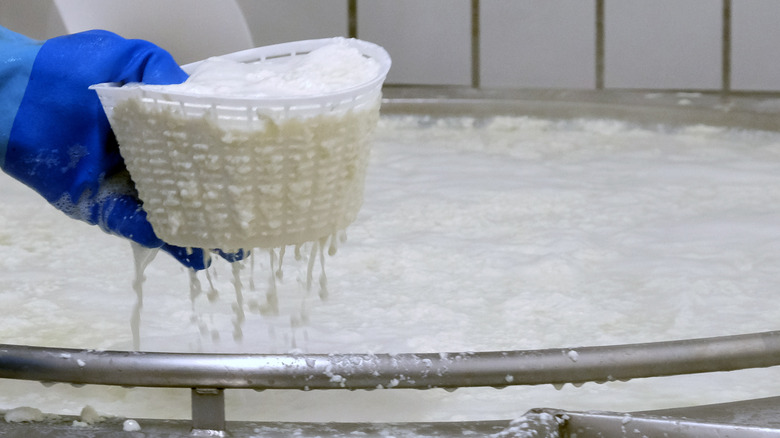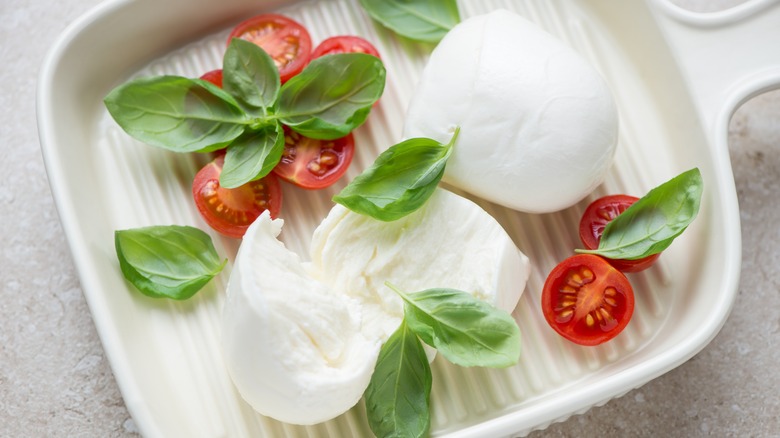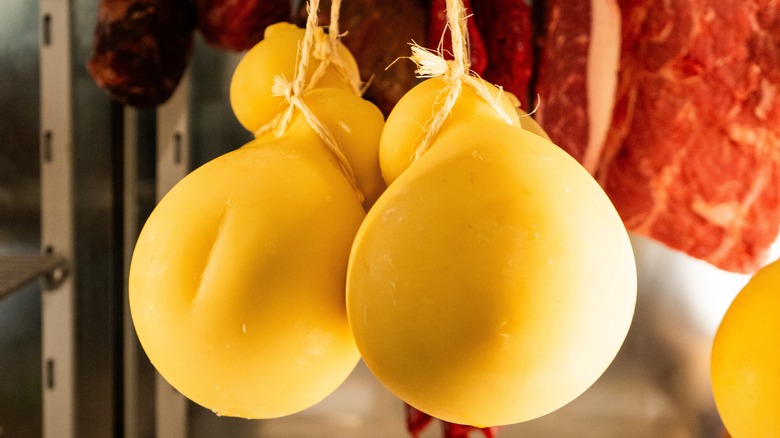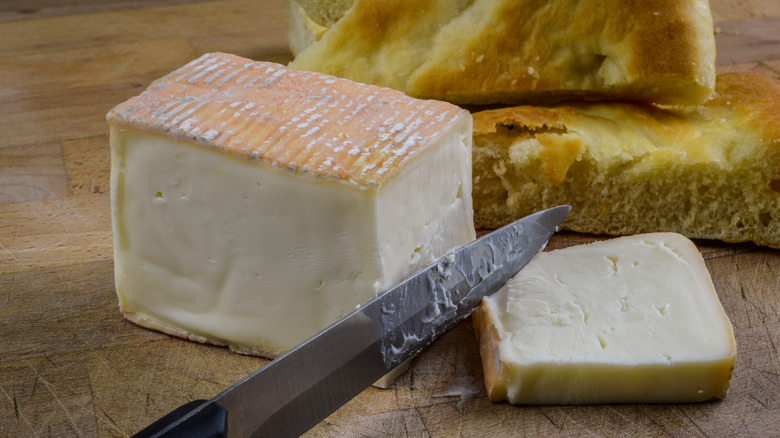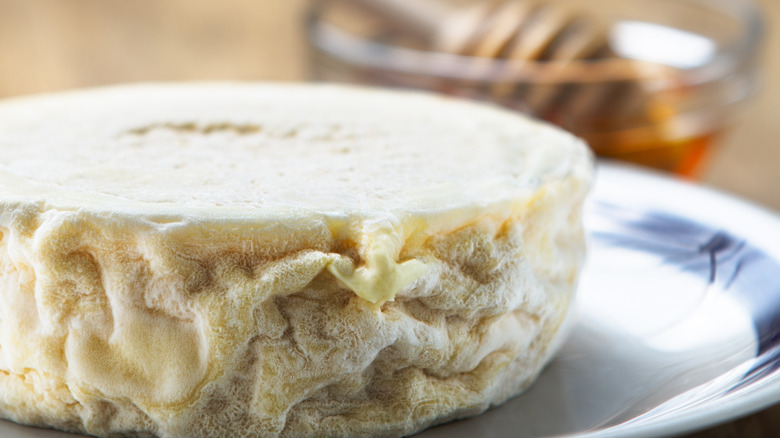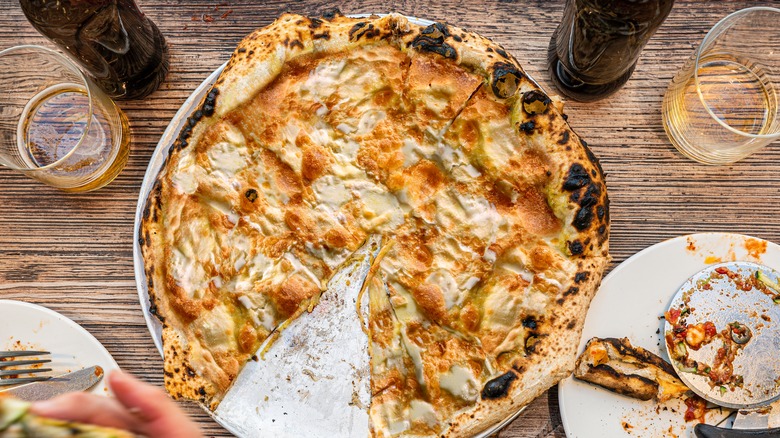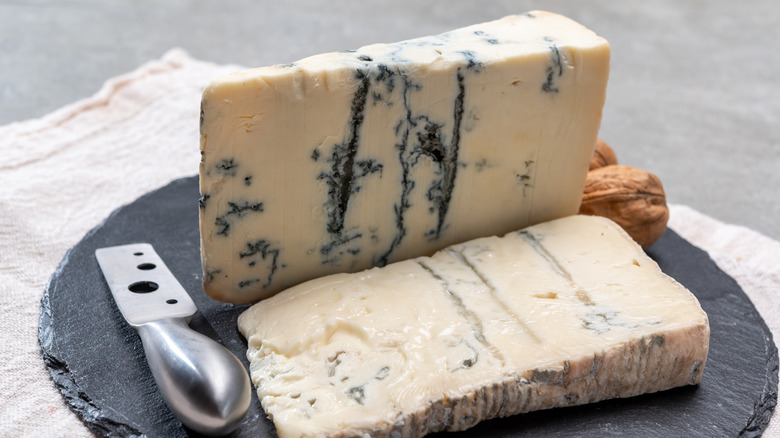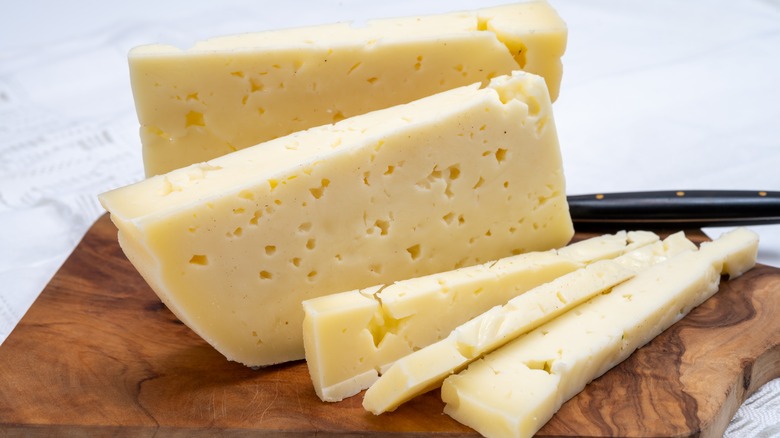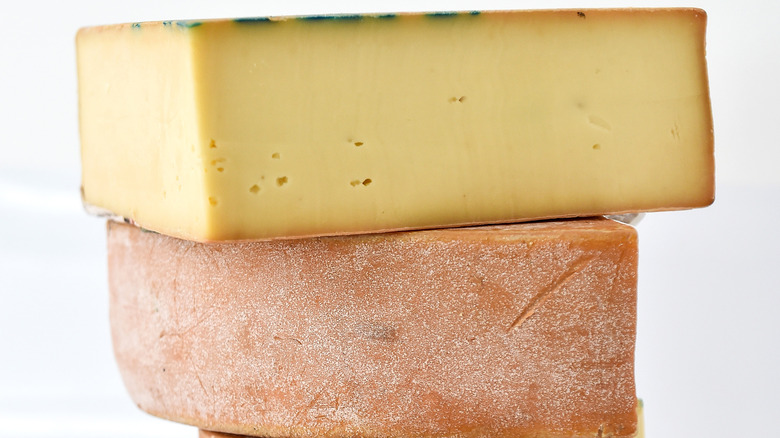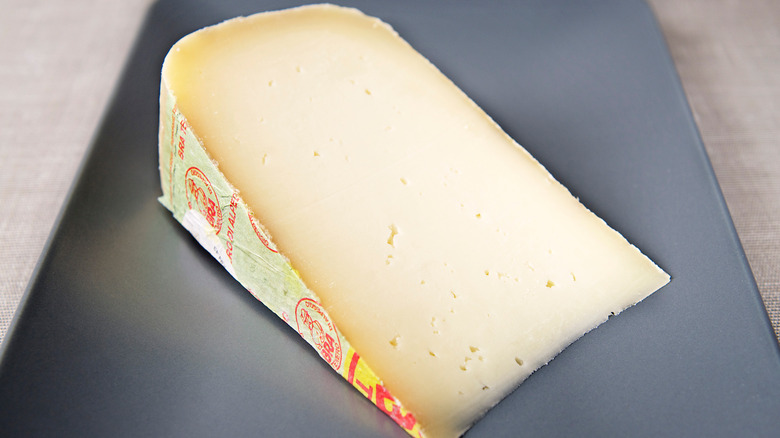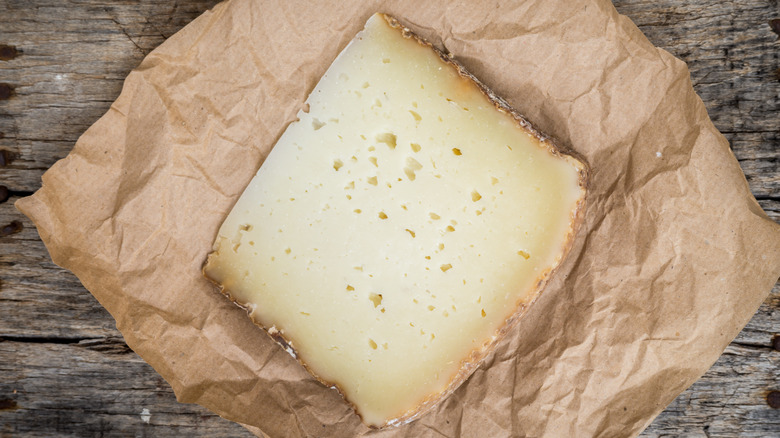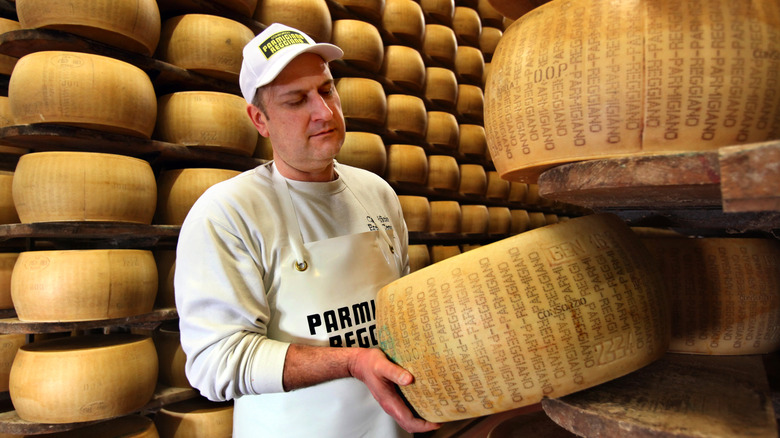13 Classic Italian Cheeses You Need To Try
People have been preserving milk by turning it into cheese for almost as long as they've been domesticating dairy animals; about 10,000 years. It's widely assumed that cheesemaking was discovered by accident, perhaps when milk was kept in a pouch made from sheep or goat stomach, a common way of storing food in ancient times. The enzymes in the stomach would have curdled the milk and begun the cheesemaking process. Today, rennet (an enzyme found in the stomach of young cows, sheep, and goats) is commonly used in cheesemaking. While cheese can be made from the milk of any herbivore — including horses and camels — cow, sheep, and goat milk is most common.
As well as grouping cheese by the type of milk used, they're most often categorized by the way they're aged (or not aged): from fresh cream and cottage-style cheeses, through those with bloomy rinds and motley reddish washed rinds, to ones veined with blue-grey mold or aged until they're firm enough to grate. Italy makes iconic examples of all types of cheeses. Some, like Parmigiano-Reggiano, are protected by an appellation (DOP) and can only be made in specific areas, while other more ubiquitous cheeses, such as ricotta, are found throughout Italy. Here's a rundown on some iconic Italian cheeses you need to try and how to incorporate them into your kitchen creations. And try to buy them from a speciality shop instead of the grocery store, if you can.
Mascarpone: Italian cream cheese
Mascarpone is simply cream curdled with a lactic acid-producing bacteria (like the bacteria used to make yogurt). It originated in the dairy-rich northern region of Lombardy around Milan as a use for the cream skimmed off milk destined to become other cheeses. While some people claim mascarpone isn't strictly a cheese because it doesn't contain rennet, it's become one of the most popular northern Italian cheeses, thanks to its inclusion in tiramisu, the creamy coffee-laced dessert Venice.
Mascarpone is thick and quite dense in its packaging, but when beaten it softens to a supple, almost elastic consistency that can be poured or drizzled, making it very versatile. Mascarpone can add a creamy tang to all sorts of dishes, from pastas and sauces to desserts. It's a decadent alternative to sour cream on baked potatoes and adds a refreshing tang when dolloped onto pies and other sweets in place of thick cream.
Ricotta: Italian cottage cheese
Like mascarpone, ricotta was originally a way to use something left over from other cheese making — in this case, the liquid created when milk curdles and splits into curds and whey. The name "ri-cotta" literally means "re-cooked" because ricotta is made by heating the whey left behind once curds have been drained. There's always some protein left in the whey and reheating it, often with a little fresh milk added for richness, causes these remaining milk solids to clump together and form a soft, fresh cheese that's incidentally relatively low-fat.
Ricotta is generally eaten within a few days of being made as its high moisture content means it sours quickly. There are, however, several options for preserving it to extend its storage life. Baking is the easiest way to preserve ricotta at home, as cooking reduces moisture content, which in turn reduces the growth of spoilage bacteria. Baked ricotta (ricotta infornata) is a delicious variation that looks almost like a cheesecake.
Salted and pressed ricotta (ricotta salata) can resemble feta or be further aged, removing more moisture, until it becomes suitable for grating. Smoked ricotta (ricotta affumicata) is also found throughout Italy. In some regions, the fresh cheese is smoked over wood, while others use local herbs, each adding their own distinctive flavor. Fresh or preserved, ricotta is versatile and used in many sweet and savory dishes. It's especially good in pastas, from classic alla Norma using ricotta salata to vegetarian cannelloni filled with spinach and ricotta.
Mozzarella: Fresh stretched curd cheeses
Mozzarella is a broad term that covers many members of the large family of cheeses made by kneading and stretching curds in very hot water to create a supple, pliable mass that can be molded into different shapes. For many cheese connoisseurs, mozzarella di bufala is the pinnacle of this "stretched curd" category which is also known as pasta filata (literally "spun paste"). Made from buffalo milk in the area around Naples in southern Italy, mozzarella di bufala is very moist with a slightly springy, almost melting, interior of layered curds inside a thin, slippery skin. It's porcelain white with a sweet, lactic tang and, combined with tomato and basil, it's the cornerstone of an authentic insalata Caprese.
Mozzarella made from cow milk (called fior di latte) is firmer and less tangy than buffalo milk mozzarella and better suited to melting in dishes rather than serving raw. Stracciatella is shreds of buffalo or cow milk mozzarella mixed with cream to create a delicious rich almost liquid cheese. Especially in the southern region of Puglia, stracciatella is wrapped inside a thin skin of mozzarella to create burrata.
Mozzarella affumicata, smoked mozzarella, is a delicious way of removing some of the moisture in fresh mozzarella to help preserve it. Other mozzarella variations are named for their shapes, from the popular bocconcini (literally "little mouthfuls") to cherry-sized ciliegine, plaited treccine, and knotted nodini. It's easy to make your own mozzarella at home and experiment with different shapes and textures.
Caciocavallo: Cheese on horseback
Cacio means "cheese" in Italian, and cavallo means "horseback," and the name of this family of aged stretched curd cheeses comes from the way they're traditionally hung to dry in pairs dangling over a rod as if astride a horse. Caciocavallo cheeses are typical of southern Italy and come in a range of sizes and ages, though they all typically have the distinctive teardrop (or gourd) shape with a knot on top around which the string securing them to their partner has been tied.
Young caciocavallo has a supple, pale yellow interior slightly firmer than commercial mozzarella, often with a few small eyes. It's an excellent melting cheese, as the stretched curd process stabilizes it so that it doesn't split and release oil when it's heated. Aged for months, sometimes years, caciocavallo becomes much drier and suitable for grating with a nutty, more complex flavor.
As caciocavallo cheeses typically weigh around 1 to 2 kilograms, and can weigh more, they're often sold in wedges rather than whole. They can also be smoked to create caciocavallo affumicata. Two similar cheeses are scamorza, typically made in southern Italy for quick sale while caciocavallo is aging, and provolone, northern Italian aged stretched curd cheeses with the same flavor profile but more often sausage-shaped or melon-shaped without caciocavallo's top knot.
Taleggio: Italy's famous washed rind cheese
Washed rind cheeses, also called smear-ripened (or smear) cheeses, are recognizable by their reddish rind. During their aging, the rind is regularly washed — generally with water but sometimes with alcohol — to encourage the growth of Brevibacterium linens bacteria, which creates the distinctive color. It also often produces an equally distinctive odor, locker room and old socks being popular descriptors among detractors of this maligned cheese family.
Thankfully, Italy's most famous washed rind cheese is relatively mild, especially on the palette. Taleggio is made in the Alpine northwest of Italy in thick 2-kilogram squares and the reddish rind is often dusted with white bloomy mold in places. Young taleggio tastes buttery, slightly nutty and spicy, becoming tangier and stronger with age. It's generally only the rind of smear cheeses that smells strongly and this can be removed before cooking, so don't let the aroma put you off. Taleggio is a beautiful melting cheese and pairs fabulously with carbs, especially in something like an Alpine potato tart. It's also a delicious way to fancy up mac and cheese.
Robiola: Delicate discs of sweet Italian cheese
Robiola is a family of Italian washed rind cheeses less commonly seen outside Italy than the popular taleggio, but well worth seeking out. Typical of the northwest region of Piedmont, robiola are generally small discs with rinds that range from bloomy white to deep red. They can be made from just one type of milk but are often produced with milk from small mixed herds of cows, sheep, and goats.
Robiola are usually eaten quite fresh — only a few days or, at the most, weeks old — so they're moist with a sweet lactic tang. Robiola is a surprisingly delicious base for a fondue made using beer instead of wine. Some robiola are wrapped in leaves, such as chestnut or fig, which add their own subtle aromas. A 100% goat milk robiola (robiola di capra) is wrapped in Savoy cabbage leaves to aid its ripening, while others, like robiola d'Alba, are scented with truffles or other seasonings. In Lombardy, rather than disk-shaped, robiola tend to be small squares, like mini-Taleggios. Flavored or natural, robiola make a delicious snack or cheese course with thin slices of raisin bread and perhaps drizzled with a little honey.
Stracchino: Perfect in focaccia
Stracchino comes from the word "stracca" meaning "tired" in the Lombardian dialect, as it was traditionally made from the milk of cows that were weary after their long walk back from the Alpine pastures at the end of summer. Stracchino cheeses are usually eaten fresh or after a few weeks of aging, so they are generally mild and spreadable.
In Liguria, they stuff focaccia dough with stracchino, which melts into a bubbly golden layer when its baked. This focaccia di recco is so good that it's been protected with a DOP appellation to ensure it's made to strict standards. Like other fresh creamy cheeses, such as ricotta or mascarpone, stracchino is delicious melted into pasta sauces or stirred through risotto as well as spread on crackers. It's very similar to cream cheese and a great alternative on bagels and sandwiches. Crescenza, the most widely available version of stracchino, is made in northern Italy typically by large producers and is moist and smooth with a mild milky flavor.
Gorgonzola: A delicious accident
Italy's most famous blue cheese gets its name from the village of Gorgonzola, which has now been absorbed into the city of Milan. The village was once a resting place for cows on their way back from the summer Alpine pastures. Legend has it that a careless cowherd left some wheels of young stracchino behind there in a cellar which were discovered months later veined with blue mold and tasting delicious.
Gorgonzola comes in three forms: dolce, picante, and in mascarpone reale. Gorgonzola piccante ("spicy"), the original, is also sometimes called Gorgonzola stagionato (meaning "aged") as it's ripened for a minimum of three months before sale. It's firm and dense with a buttery texture and sharp, spicy flavor. As such a bold blue cheese isn't to everyone's taste, in the 1930s, Gorgonzola dolce ("sweet") was developed. Aged for only two months and higher in fat, dolce has a softer, creamier texture, less blue mold, and a milder, sweeter taste. Mascarpone reale is a combination of mascarpone and Gorgonzola, sometimes blended, sometimes layered into a torta that's often studded with walnuts. Gorgonzola dolce is a great starting point for people just beginning to explore blue cheese and can add oomph to many dishes, from soups and pastas to burgers and dressings.
Asiago: Cooked pressed curd cheese
In the remote Alpine regions of Italy, wheels of cheese traditionally needed to be stored for weeks or months before the long trip down to a town for sale. To make cheese that can be stored for a long time, the curds need to be pressed to remove as much moisture as possible. To expedite this, the curds are first heated so they contract and squeeze out a lot of the moisture as whey. Asiago is a typical Italian cooked pressed curd cheese from the northeastern regions of Veneto and Trentino-Alto Adige.
Asiago is made in large wheels, typically weighing between eleven and 15 kilograms. The size means that while the rind hardens to protect the cheese, the interior remains supple. Aged for just a month or so (called "pressato") its flavor is mild and buttery. After two months of aging, it becomes Asiago d'Allevo and, over time, the interior hardens and becomes crumblier with a complex nutty flavor. Aged for a year or more, it's used for grating like Parmigiano. Having already been cooked, Asiago melts well without becoming oily; add some to scrambled eggs for a breakfast to remember.
Fontina: Washed rind mountain cheese
The Aosta Valley, pressed against France and Switzerland in Italy's north-eastern Alps, is the country's smallest and most mountainous region. On the typical little farms of the region, milk had to be gathered over several days to produce the traditional large, firmly pressed wheels of cooked curd cheese that would store well until the long journey to a market town for sale.
Similar in many ways to the cooked pressed curd Asiago of northwestern Italy, fontina is aged for around three months and the interior remains supple and semi-soft. It has added complexity from the washed rind, which gives it a distinctive orange hue; earthy, mushroomy aroma; and a more savory flavor. Fontina is an essential ingredient in many traditional Aostan dishes such as fonduta, Italy's answer to Swiss fondue. It melts beautifully and is delicious stirred into polenta and risotto as well as in pasta bakes. For something totally different, serve Fontina with chocolate peppermint bark.
Testun and Bra: Mixed milk Alpine cheeses
Unlike large wheels of Asiago and fontina, testun and bra were traditionally smaller cheeses made for family consumption while the more valuable large wheels were saved for sale. Typical of the northeastern corner of Italy, especially Alpine Piedmont, these cheeses are often made from the milk of mixed herds of cows, goats, and sheep.
Testun is a dialect word meaning "big, hard head" to describe the cheese's shape, while Bra is named for the Piedmontese market town where the cheeses were often sold. Today, Bra is the headquarters of the Slow Food Movement and, appropriately, home to its biennial Slow Cheese Festival.
Testun and bra cheeses are generally sold at two different levels of maturity. Aged for two to six months, tenero ("tender") is the softest with a mild, milky flavor and herbal notes from the Alpine grasses the cows feed on. Duro ("hard") is aged for over six months and is darker and firmer becoming crumbly with a tangy flavor as it matures.
Whether tenero or duro, these cheeses are delicious as an after-dinner cheese course with crackers or dark bread and Italian mustard fruit chutney. Testun al Barolo is made from a blend of cow and goat milk, soaked in local Barolo wine and coated with crushed grape skins which give the interior an unusual purplish-pink hue and a strong fermented flavor.
Pecorino: Italian sheep milk cheese
Along with goats, sheep were the original dairy animals, long before cows became our primary source of milk. Whereas cattle require relatively flat, lush fields to graze, sheep are comfortable on more undulating land and sparser pastures. They're therefore better suited to much of Italy's terrain, especially the rocky, more arid south.
Pecora is the Italian word for "sheep" and pecorino is the general term for Italian sheep milk cheese. Pecorino cheese is made across Italy, especially the south, and often named for its region. The most famous are Pecorino Toscano from Tuscany, Lazio's Pecorino Romano, Pecorino Sardo from Sardinia, and Sicilian Pecorino Siciliano, all of which are protected by DOP appellations. Pecorino cheeses are most often cooked pressed curd cheeses aged until they're hard enough for grating (and are different from Parmesan). They are however sometimes served "dolce" (meaning "sweet") after just a few weeks aging, when the flavor is mild and milky. Dolce Pecorino Sardo is even traditionally used in Sardinia's famous seadas, a dessert of deep-fried cheese-filled ravioli.
Pecorino pepato, studded with black peppercorns is especially popular in Sicily. In Emilia-Romagna, pecorino foglie di noce is wrapped in walnut leaves for aging, while Formaggio di Fossa is a pecorino aged in underground caves.
Sheep milk cheeses are paler than those made from cow milk, with a waxier texture and a distinctive aroma that can take a bit of getting used to. Tuscan and Sardinian pecorinos are the mildest and Pecorino Romano is the strongest. Avoid any cheese labelled "pecorino" but made from cow milk.
Parmigiano-Reggiano and Grana Padano: Premium grating cheeses
While the word "Parmesan" can refer to hard grating cheeses the world over, there's a big difference between the premium grating cheeses of Italy and the pre-grated, rancid-smelling powders that give Parmesan a bad name. Grana, referring to such cheese's granular texture, is another name for this ancient style of cheese traditionally made in 20 kilogram to 50 kilogram wheels. These cheeses were very important in medieval times when they were even used as currency and security because they kept well and were easily transported.
Northern Italy makes two premium grating cheeses in neighboring regions: Parmigiano-Reggiano (in Emilia-Romagna) and Grana Padano (in Lombardy). While Parmigiano-Reggiano has the strictest production criteria and attracts the highest price, Grana Padano is an excellent cheese that can be used interchangeably in most instances. The curds for both cheeses are very finely cut and heated to release as much whey as possible, so that they can be matured for at least a year (nine months for Grana-Padano), generally much longer. At 12 to 18 months they're generally eaten as a snack; 24 months is the sweet spot where they're both grated and served in pieces; and over 24 months they're generally grated and used in cooking. They can be aged for up to four years or longer. Next time you need a grating cheese, reach for Grana Padano or Parmigiano-Reggiano rather than just any old Parmesan.

